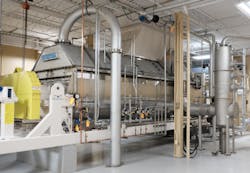Komline-Sanderson, www.komline.com, 908.234.1000
Nestled in southeast Tennessee east of Knoxville along the Pigeon River, Newport is home to 7,000 people and Stokely-Van Camp’s (ConAgra) food processing plant. But the growth industry is a traditional one in the Appalachian foothills: moonshine! Or now, more appropriately, three legal distilleries.
The current wastewater treatment plant is designed for 4.35 million gallons per day (mgd), was commissioned in September of 1979 just across the road from the old plant, and today operates at 3 mgd of which almost 60% is from the food processing plant. The incoming BOD is 800 mg/L. The plant services 4,400 domestic customers over an area of 33 square miles with 70 miles of sewer lines and 43 pumping stations. The Newport Utilities wastewater treatment plant has been awarded the WEF Operational Excellence Award in 12 consecutive years and 18 times in the last 23 years. It did so with only 13 employees.
The influent first passes through rotary screens with 40-µ openings to catch bean hulls from the food processing plant and then on to ‘T’ cup grit removal. Following the aeration basins are four secondary clarifiers, a nitrification tower for ammonia stripping, and a traveling bridge sand filter, chlorine contact chamber, and sodium hypochlorite disinfectant prior to discharging the treated liquid. The solids then go on to dewatering and drying.
Newport has three 350,000 sludge tanks that fill continuously. During filling, no dewatering or drying occurs. Then, 24 hours per day for 10 to 12 days, the solids are dewatered to 19% dry solids from a feed of 2.5% dry solids on two Komline-Sanderson Kompress GRS-2 belt filter presses commissioned in January 2000. Since these presses have performed so well for so many years, Newport invested in more Komline-Sanderson technology. In 2016 Chuck Brown, of Southeastern Construction Services, installed a Komline-Sanderson biosolids drying system to replace an existing dryer which was not performing to specification.
The K-S system had to be designed to fit into the existing building and use as many existing components as possible. Colin Dray led the Komline-Sanderson team entrusted with this task.
The result was a system that Wastewater Lead Operator Chris Archer said “worked perfectly the first time we pushed the button.” The solids are dewatered on the second floor and transferred via an existing shaftless screw conveyor approximately 30 feet to the adjoining building and fall into the K-S supplied live bottom dryer feed hopper on the ground floor.
A new progressing cavity pump then transfers the cake upstairs to the K-S dryer. After being dried to Class A quality, the solids are cooled in a jacketed and shaft cooled screw conveyor adjacent to the dryer prior to dropping back down to the ground floor to be transported with an existing dilute phase pneumatic conveyor to the previous 3,720 cubic feet product silo just outside the building. The new thermal fluid heater is located in a separate room behind the pneumatic conveyor.
Currently, local farmers are paying a delivery charge for a 12 to 14 ton load of the dried Class A Biosolids. The dryer is fueled with natural gas, which heats thermal fluid to 395°F. The utilities cost per dry ton of product is approximately $70. That is $12 per wet ton compared to a $25 per wet ton tipping fee at the landfill.
Newport expects the belt filter presses and the Komline-Sanderson biosolids drying system to keep running long into Archer’s tenure.
